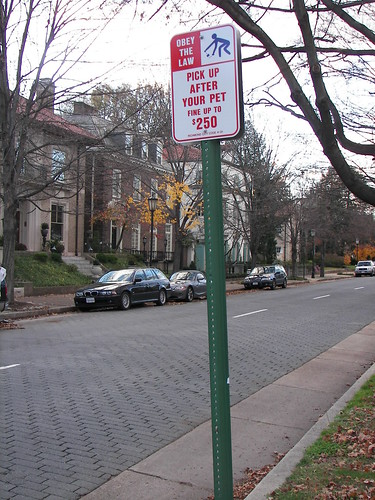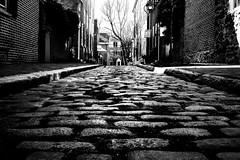Traffic calming through materials
(Belgian Block in Philadelphia, a Flicker photo by LSC21. This is less machined. The DC and Richmond versions are machined so that the experience if driving or walking or biking on the material is not overly uncomfortable. If you've walked or ridden or driven on cobblestones in Georgetown DC, I would aver it's uncomfortable.)
From the ANC6A e-list, Rick Sundberg writes:
Another proven traffic calming technique, widely used in European cities, is returning one way streets to two way. Eliminating one way in the morning and returning Independence to two way would be logical places to start.
My response:
I keep suggesting this re G and I Streets. G goes one way west, I one way east. They have negligible traffic. And historically, because of the negligible traffic, the vacuum of activity supported the growth of negative activity--drug sales and aggressive loitering. (Much of the discussion was on the hstreetdc@yahoogroups.com list.)
Yet, many less empirically inclined residents challenged the suggestion.
Lately, I do appreciate more people's desire for traffic calming. But I don't think that Greater Capitol Hill residents have it as bad as they think. The attached housing modality on the neighborhood streets, narrow streets, tree-lined streets, etc., "enclose" the street better (see probably the absolute best book on the subject, _Livable Streets_ by Donald Appleyard--I just skimmed it last week, amazing; he breaks down residential and residentical-commercial mixed use streets by traffic level -- low, medium, high and very high), leading to a major reduction in prevailing speeds.
In Brookland, where I work, the streets have less traffic, and the housing density is much lower, plus houses tend to be set back much futher from the street. (Although this might be an illusion based on the density differential). Newly paved roads mean that cars are enabled to speed very fast down "side" streets--100% residential streets like Lawrence or Newton--plus they have hills that going east, speed driving further.
I understand the desires better now for speed bumps. Seeing this in Mt. Rainier too, where they have speed bumps, but approximately 28 foot wide streets, vs. 32 food wide residential streets in Brookland. Mt. Rainier doesn't allow parking on both sides. DC does for the most part. This makes a huge difference with regard to prevailing speed, and speeding between bumps and tables (i.e., they speed between bumps in Mt. Rainier, and between speed tables on Lincoln Park).
Again, I believe it comes down to materials. Even streets where the posted (or unposted) limits are 25 mph are constructed out of materials (asphalt or concrete) that allow for much higher speeds. Therefore, the materials should be changed to better link desired speeds, posted speeds, and actual speeds.
Therefore, as I say, Belgian Block, and similar materials are in order. Along with two-way streets, and parking on both sides of streets.

Belgian Block on Monument Avenue in Richmond. Note that there isn't two sided parking, and the streets are wider, but speeds are reduced over an equivalent road paved in concrete or asphalt.




0 Comments:
Post a Comment
<< Home